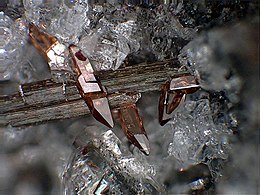Titanite
Appearance
| Titanite (Sphene) | |
|---|---|
 Titanite crystals on amphibole (image width 2 mm) | |
| General | |
| Category | nesosilicate |
| Formula (repeating unit) | CaTiSiO5 |
| Strunz classification | 9.AG.15 |
| Crystal symmetry | P21/a |
| Unit cell | a = 7.057 Å, b = 8.707 Å c = 6.555 Å; β = 113.81°; Z = 4 |
| Identification | |
| Colour | Reddish brown, brown, gray, black, yellow, green, or red, colourless |
| Crystal habit | Flattened wedge-shaped crystals, also massive |
| Crystal system | Monoclinic |
| Twinning | Contact and penetration on {100}, lamellar on {221} |
| Cleavage | Distinct on [110], parting on {221} |
| Fracture | Sub-conchoidal |
| Mohs scale hardness | 5 to 5.5 |
| Luster | Subadamantine tending to slightly resinous |
| Streak | Reddish white |
| Diaphaneity | Translucent to transparent |
| Specific gravity | 3.48 to 3.60 |
| Optical properties | Biaxial (+); very high relief |
| Refractive index | nα = 1.843 – 1.950 nβ = 1.870 – 2.034 nγ = 1.943 – 2.110 |
| Birefringence | δ = 0.100 – 0.160 |
| Pleochroism | Strong: X = nearly colorless; Y = yellow to green; Z = red to yellow-orange |
| 2V angle | 17 to 40° (measured) |
| Dispersion | r > v strong |
| Other characteristics | |
| References | [1][2][3][4] |

Titanite, or sphene (from the Greek sphenos (σφηνώ), meaning wedge[4]), is a calcium titanium silicate mineral. Its chemical formula is CaTiSiO5. Iron and aluminium are sometimes found in it. Also sometimes found in it are rare earth metals including cerium and yttrium, and the actinide thorium.[5]
References
[change | change source]- ↑ "Handbook of Mineralogy" (PDF).
- ↑ "Webmineral data".
- ↑ "Mindat".
- ↑ 4.0 4.1 Dana, James Dwight; Ford, William Ebenezer (1915). Dana's Manual of Mineralogy for the Student of Elementary Mineralogy, the Mining Engineer, the Geologist, the Prospector, the Collector, Etc (13 ed.). John Wiley & Sons, Inc. pp. 299–300. Retrieved 2009-07-06.
- ↑ Deer, W. A.; Howie, R. A.; Zussman, J. (1966). Introduction to the Rock-Forming Minerals. Longman. pp. 17–20. ISBN 0-582-44210-9.
